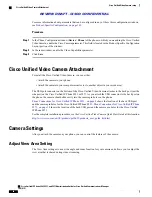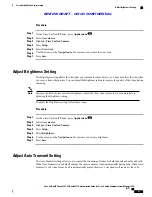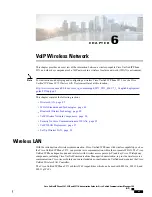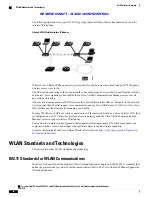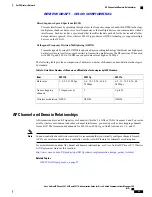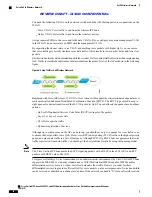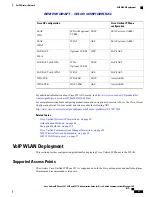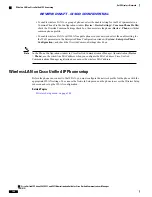
Direct-Sequence Spread Spectrum (DSSS)
Prevents interference by spreading the signal over the frequency range or bandwidth. DSSS technology
multiplexes chunks of data over several frequencies so that multiple devices can communicate without
interference. Each device has a special code that identifies the data packets for the device and all other
data packets are ignored. Cisco wireless 802.11b/g products use DSSS technology to support multiple
devices on the WLAN.
Orthogonal Frequency Division Multiplexing (OFDM)
Transmits signals by using RF. OFDM is a physical-layer encoding technology that breaks one high-speed
data carrier into several lower-speed carriers to transmit in parallel across the RF spectrum. When used
with 802.11g and 802.11a, OFDM can support data rates as high as 54 Mbps.
The following table provides a comparison of data rates, number of channels, and modulation technologies
by standard.
Table 12: Data Rates, Number of Channels, and Modulation Technologies by IEEE Standard
802.11a
802.11g
802.11b
Item
6, 9, 12, 18, 24, 36, 48,
54 Mbps
6, 9, 12, 18, 24, 36, 48,
54 Mbps
1, 2, 5.5, 11 Mbps
Data rates
Up to 23
3
3 (Japan uses 4)
Nonoverlapping
channels
OFDM
OFDM
DSSS
Wireless modulation
AP Channel and Domain Relationships
APs transmit and receive RF signals over channels within the 2.4 GHz or 5 GHz frequency band. To provide
a stable wireless environment and reduce channel interference, you must specify nonoverlapping channels
for each AP. The recommended channels for 802.11b and 802.11g in North America are 1, 6, and 11.
In a non-controller-based wireless network, we recommend that you statically configure channels for each
AP. If your wireless network uses a controller, use the Auto-RF feature for minimal voice disruption.
Note
For more information about AP channel and domain relationships, see
Cisco Unified IP Phone 9971 Wireless
LAN Deployment Guide
at this location:
http://www.cisco.com/en/US/products/ps10453/products_implementation_design_guides_list.html
Related Topics
VoIP WLAN Deployment, on page 97
Cisco Unified IP Phone 8961, 9951, and 9971 Administration Guide for Cisco Unified Communications Manager 10.0
(SIP)
89
VoIP Wireless Network
AP Channel and Domain Relationships
REVIEW DRAFT - CISCO CONFIDENTIAL






